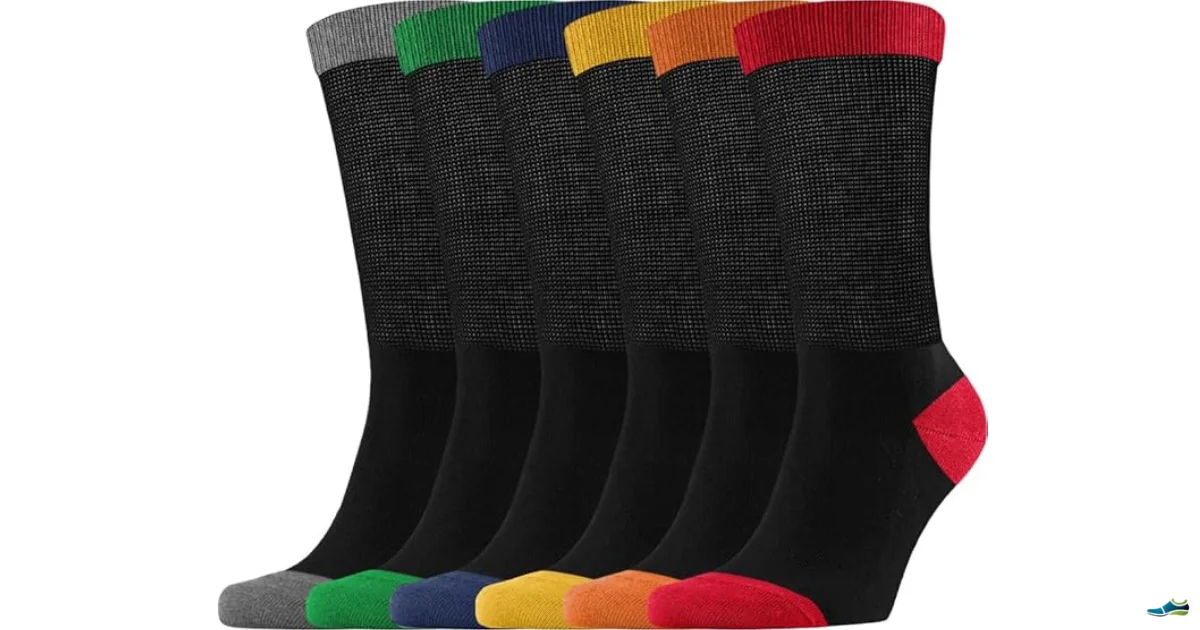If your socks dig trenches into your legs, it’s not your circulation that’s weak — it’s the design. The best diabetic and non-binding socks aren’t medical gimmicks; they’re everyday comfort with the pressure turned down. Think of them as your feet’s peace treaty: steady support without the squeeze.
📌 At a Glance
- ✔️ Gentle cuffs hold without leaving “ring” marks or welts.
- ✔️ Seam-free toes protect fragile skin and neuropathic feet.
- ✔️ Breathable bamboo and merino blends regulate heat and moisture.
- ✔️ Perfect for anyone who values circulation and comfort — not just those with diabetes.
If swelling is your main issue, start with Socks & Tights for Swollen Feet (Oedema); it breaks down how cuff width and fibre choice affect comfort through the day.
Why ordinary socks get it wrong
Most high-street socks are built for looks, not circulation. Tight cuffs and rough seams cut into skin, block blood flow and cause those deep ridges around your ankles by lunchtime. “Support” is often marketing code for “suffocating”.
If you’ve ever peeled off a pair that left red welts, you’ve experienced what non-binding socks were designed to fix — comfort that lasts longer than a coffee break.
What makes a true non-binding sock
- Wide, soft cuffs: They hold without strangling. The pressure is spread evenly, not focused on a single band.
- Elastic-light knit: Gentle stretch through the leg and ankle so the sock stays up naturally.
- Seamless or hand-linked toes: No ridge to rub across sensitive joints or bunions.
- Breathable fibres: Let heat escape instead of trapping moisture (a big win for neuropathy and swelling).
- Flat interiors: No bulky threads digging into the skin.
Good pairs feel like they disappear once you’ve got them on — which is the whole point.
Inside the Sock: What Your Skin Actually Touches
- Hand-linked or flat toes: ridge height kept tiny to avoid rubbing on bunions and tender joints.
- Turned, covered elastane: no bare rubber against skin; gentler for neuropathy and fragile skin.
- Low-pile terry under forefoot: reduces shear when you walk, without bulking the toe box.
- Smooth interior finish: no scratchy threads to catch or irritate.
Calm-Skin Fibres
- Bamboo/viscose: cool, breathable, moisture-managing.
- Fine-gauge merino: warm without bulk; balances temperature all day.
- Cotton-rich + a touch of elastane: familiar feel with reliable recovery.
- Optional odour control: silver/zinx finishes help freshness (comfort first, not a cure).
What to look for (and what to ditch)
- Look for: “Non-binding”, “loose welt”, “diabetic-friendly”, “extra wide cuff”.
- Avoid: “One size fits all” (translation: “one size fits none”).
- Look for: Bamboo, merino, or cotton-rich blends with a hint of elastane.
- Avoid: Heavy acrylic or nylon — they trap sweat and shrink in the wash.
- Look for: Flat seams or “hand-linked toe”.
- Avoid: Tight ribbing that digs in after an hour.
If you’re still left with marks or tingling, the problem isn’t your legs — it’s your socks.
Who should wear them (hint: almost everyone)
- Swollen feet or ankles? You’ll love the loose hold. See also: Best Socks & Tights for Swollen Feet (Oedema).
- Diabetes or circulation issues? Non-binding = less pressure, better blood flow.
- Bunions or hammer toes? Seam-free toes stop rubbing where it hurts. Read: Hosiery for Wide Feet: The Complete Comfort Guide.
- Just sick of tight socks? You qualify. It’s not a diagnosis — it’s self-respect.
Best materials for sensitive feet
Prioritise fibres that move with you: bamboo for cooling, merino for warmth without bulk, and cotton-rich blends with a touch of elastane for recovery. Avoid heavy synthetics — they trap heat and moisture, the enemies of calm skin.
How to check the fit (quick test)
The best test? Put them on mid-afternoon and forget about them. If you notice the cuff, it’s too tight. If your toes feel crowded, the knit’s too shallow. True non-binding socks make you forget you’re wearing them at all.
How diabetic socks differ
Despite the name, diabetic socks aren’t just for people with diabetes. They’re built to reduce friction, moisture, and constriction — three things that cause ulcers, blisters, and inflammation. Think of them as the luxury version of everyday socks.
- No tight ribbing or harsh elastics.
- Seam-free toes to protect fragile skin.
- Moisture-wicking fibres (bamboo, cotton, merino).
- Extra depth and stretch for swelling or bandages.
The golden rule? If a sock leaves a mark, it’s working against you — not for you.
For those who need a touch more lift — say after long hours on your feet — Compression Socks Made Simple explains how to size them so they support rather than strangle.
Care & longevity
- Wash inside out on gentle; skip fabric softener (it kills stretch).
- Air-dry — high heat ruins fibres and shape.
- Replace pairs when cuffs stop recovering or toes thin.
Non-binding and diabetic socks aren’t a luxury — they’re a quiet revolution for tired legs. Once you’ve tried them, you’ll wonder how you ever put up with the old kind.
Related Reads
- The Best Socks for Standing All Day
- Hosiery for Wide Feet: The Complete Comfort Guide
- Best Thin Socks for Wide Feet
- How to Measure Foot Width at Home
FAQs
Are silver-thread socks worth it?
They can reduce odour, but comfort and fit matter more. Choose gentle cuffs and flat seams first.
How often should I check my feet with neuropathy?
Daily. Look for colour changes, blisters or rubbing — change sock style/size at the first sign.
Will non-binding socks slip in dress shoes?
Pick a soft rib and your usual length; if slipping happens, try a light midfoot grip (no tight bands).

